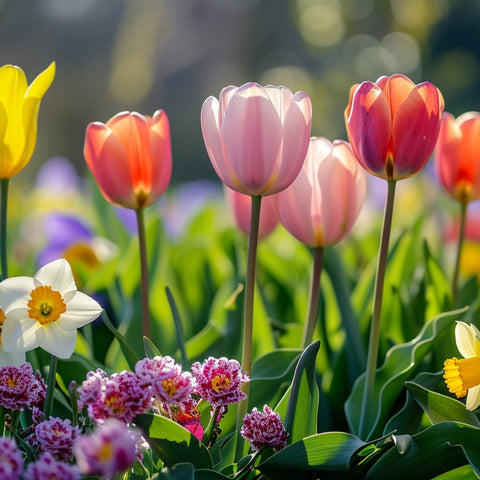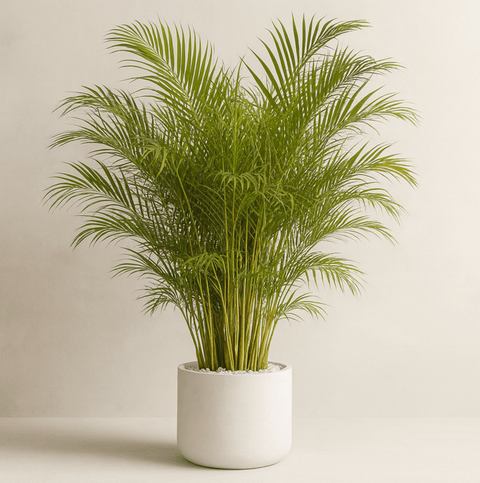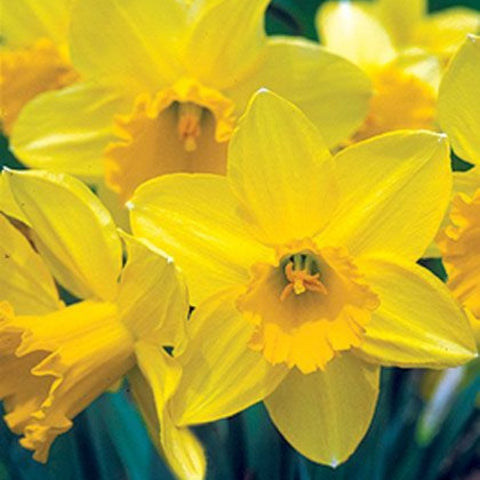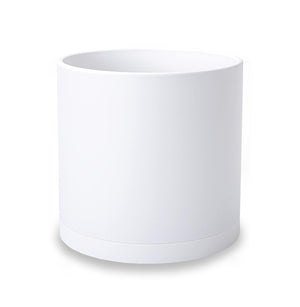Blog Post : Bulbs to Plant in April: A Guide to Creating a Stunning Spring Garden

As the days grow longer and the weather warms, April marks the perfect time to start planting bulbs for a beautiful spring garden. Not only does planting bulbs in April allow them to establish strong root systems before the arrival of summer heat, but it also ensures a vibrant and colorful display of flowers when spring finally arrives. In this comprehensive guide, we will explore the top 5 bulbs to plant in April, provide tips for successful planting, and share additional considerations for enhancing the beauty of your garden.
1. Tulips

Bringing Splashes of Color to Your Garden
Tulips are undoubtedly one of the most popular spring-blooming bulbs. With their wide array of colors and distinctive shapes, tulips can add splashes of vibrant beauty to any garden. From the classic single and double tulips to the elegant lily-flowered and parrot tulips, the choices are endless. To choose the right tulip bulbs for your garden, consider factors such as bloom time, height, and color.
When planting tulips in April, it is important to ensure they receive adequate sunlight and well-drained soil. Dig a hole that is about twice the depth of the bulb and place the bulb with the pointed end facing up. Cover the bulb with soil and water thoroughly. Remember to provide regular watering and fertilization throughout the growing season to encourage healthy growth and abundant blooms.
2. Daffodils

Delighting the Senses with Delicate Beauty
Daffodils, also known as narcissus, are renowned for their trumpet-shaped blooms and delicate fragrance. These cheerful flowers come in a variety of types, including large-cupped, small-cupped, and double-flowered daffodils. When planting daffodil bulbs in April, choose a location with well-drained soil and full sun or partial shade.
Before planting, it is important to allow the daffodil bulbs to dry out for a day or two after purchase. This helps prevent fungal infections. Dig a hole that is approximately three times the height of the bulb, and plant the bulbs with the pointed ends facing up. Water the bulbs well after planting, and continue to water them regularly during the growing season for optimal results.
3. Hyacinths

Adding Fragrance and Elegance to Your Garden
Hyacinths are beloved for their intoxicating fragrance and vibrant colors. These compact beauties come in a range of hues, including pink, blue, white, and purple. To plant hyacinth bulbs in April, choose a location with well-drained soil and full to partial sun.
Prepare the soil by removing any weeds or debris and loosening it with a garden fork. Plant the bulbs around 4-6 inches deep and 6-8 inches apart, with the pointed ends facing up. Water the bulbs thoroughly after planting, and provide regular watering throughout the growing season. To protect the bulbs from harsh weather conditions, consider adding a layer of mulch around them.
4. Crocus

Welcoming the Arrival of Spring with a Sea of Colors
Crocus flowers are often the first to bloom in spring, providing a burst of color after a long winter. These dainty flowers come in a variety of shades, from vibrant yellows and purples to delicate whites and blues. To plant crocus bulbs in April, choose a well-drained location with full or partial sun.
Prepare the soil by removing any weeds or rocks and loosening it with a garden fork. Plant the bulbs around 3-4 inches deep and 2-3 inches apart, with the pointed ends facing up. Water the bulbs immediately after planting, and continue to water them throughout the growing season, especially during dry periods. With their naturalizing tendencies, crocus bulbs will multiply and create breathtaking displays year after year.
5. Alliums

Adding Height and Drama to Your Garden
Alliums are known for their large spherical blooms and architectural presence. These unique flowers come in various shades of purple, white, and blue, and they make a striking statement when planted in groups. To plant allium bulbs in April, choose a location with well-drained soil and full sun.
Dig a hole that is about two times the diameter of the bulb and two times the bulb's height deep. Place the bulb in the hole with the pointed end facing up, and cover it with soil. Ensure adequate spacing between the bulbs to allow for proper airflow and growth. Water the bulbs thoroughly after planting, and provide regular watering throughout the growing season. Alliums are low-maintenance plants that add height and drama to any garden.
Tips for Successful Bulb Planting in April
A. Understanding Your Local Climate and Hardiness Zones
Before planting bulbs in April, it is crucial to understand your local climate and the specific hardiness zones in your area. Different bulbs have different temperature requirements, and planting bulbs that are not suited to your climate can result in poor growth or lack of blooms. Research the recommended planting times and hardiness zones for each type of bulb to ensure success.
B. Preparing the Soil for Bulb Planting

Proper soil preparation is essential for the success of bulb planting. Ensure that the soil is well-drained and free of weeds and debris. Loosen the soil with a garden fork to improve aeration and drainage. Adding organic matter, such as compost or well-rotted manure, can also help improve soil fertility and structure.
C. Properly Selecting, Handling, and Storing Bulbs
When selecting bulbs for planting, choose ones that are firm, plump, and free from any signs of mold or damage. Handle the bulbs carefully to avoid bruising or causing damage to the protective outer layer. Before planting, store the bulbs in a cool, dry place to prevent premature sprouting or deterioration.
D. Choosing the Right Location and Spacing for Bulbs in a Garden
The location and spacing of bulbs in your garden can significantly impact their growth and visual impact. Choose a location that provides the appropriate sunlight and soil conditions for the specific type of bulbs you are planting. Ensure adequate spacing between bulbs to allow for proper airflow and growth. Consider planting bulbs in groupings or clusters for a more natural and eye-catching display.
E. Providing Adequate Watering and Fertilization
Watering and fertilizing bulbs correctly is crucial for their growth and overall health. After planting, water the bulbs thoroughly to settle the soil and provide moisture for root development. Throughout the growing season, provide regular watering to keep the soil evenly moist, especially during dry periods. Applying a balanced bulb fertilizer according to the package instructions can also promote healthy growth and abundant blooms.
F. Protecting Bulbs from Pests and Diseases
Bulbs can be susceptible to various pests and diseases, such as squirrels, mice, and fungal infections. To protect your bulbs, consider using fencing or wire mesh to deter animal pests. Applying repellents or using natural deterrents, such as garlic spray or cayenne pepper, can also help. Additionally, ensuring proper soil drainage and avoiding overwatering can help prevent fungal diseases.
Additional Considerations
A. Companion Planting with Bulbs for Enhanced Beauty and Biodiversity
Companion planting involves planting different varieties of plants together to enhance their growth and beauty. Consider pairing bulbs with complementary plants, such as perennials or annuals, to create visually stunning combinations. Additionally, companion planting can help attract beneficial insects and improve biodiversity in your garden.
B. Incorporating Bulbs into Container Gardens or Indoor Displays
Bulbs can also be planted in containers or pots, allowing you to enjoy their beauty indoors or on a patio or balcony. Choose shallow containers with drainage holes, and use well-draining potting soil specifically formulated for containers. Place the bulbs in the container according to the planting depth recommendations, and provide regular watering and fertilization.
C. Extending the Flowering Period by Planting Bulbs with Staggered Bloom Times
To create a longer-lasting display of flowers, consider planting bulbs with staggered bloom times. By choosing bulbs that flower at different times, you can enjoy a continuous show of color and fragrance throughout the spring. Research the bloom times of different bulb varieties and plan your planting accordingly.
Conclusion
Planting bulbs in April is a rewarding and exciting endeavor that can bring a burst of color and fragrance to your garden. By choosing the right bulbs, preparing the soil, and providing proper care, you can create a stunning spring display that will awe and delight. Remember to research the specific planting requirements for each type of bulb and consider additional considerations like companion planting and container gardening to enhance the beauty of your garden. Start planting those bulbs now and prepare for a breathtaking spring garden!






























Comments (0)
There are no comments for this article. Be the first one to leave a message!